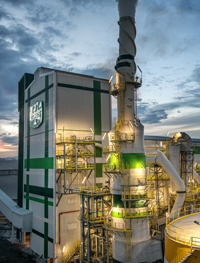
Samsun Production Plant
The plant was started to be built in 1967 by Samsun Fertilizer Industry in order to meet the demand for nitrogenous and phosphatic fertilizers in Turkey and it was commissioned in two stages in 1970 and 1973, respectively.
Samsun Fertilizer Plant, operating under the structure of the public enterprise Türkiye Gübre Sanayi A. Ş. (TÜGSAŞ) was acquired by Toros Agri under the scope of privatization in 2005 and then, rehabilitation works were started quickly. After such renovation works, the plant started production again in 2006; and it now produces NP/NPK compound fertilizer and Diammonium Phosphate (DAP) fertilizer, which are commonly used in Turkey. The plant has a production capacity of 575.000 tons/year of fertilizers.
The new USD 335 million investment started by Toros Agri in 2012 under the structure of Samsun Production Plant in order to reduce its import dependency for raw material supply was put into operation by the end of 2015. The investment covers establishment of a new plant that will allow for production of sulphuric acid, an important raw material in the production of phosphatic fertilizer, and increasing the existing phosphoric acid production capacity and rehabilitation of the compound fertilizer (NPK) plant.
The new plant is expected to decrease the import dependency of Toros Agri by USD 88 million per year, and thus make a significant contribution for the current deficit problem of the Turkish economy. In addition, thanks to the investment converting the heat energy emitted during sulphuric acid reaction into electricity, the natural gas and electricity requirements of the plant will be completely met, thereby making significant energy savings. It is expected that the clean energy to be generated will contribute in the national economy by providing a saving of USD 16.7 million per year in the electricity generation and a saving of USD 5.3 million per year due to the reduction in the natural gas imports.
As with Ceyhan Terminal, Toros Samsun Terminal operated under the structure of the plant also has a convenient structure for handling of both bulk solid cargoes and liquid chemical products.

